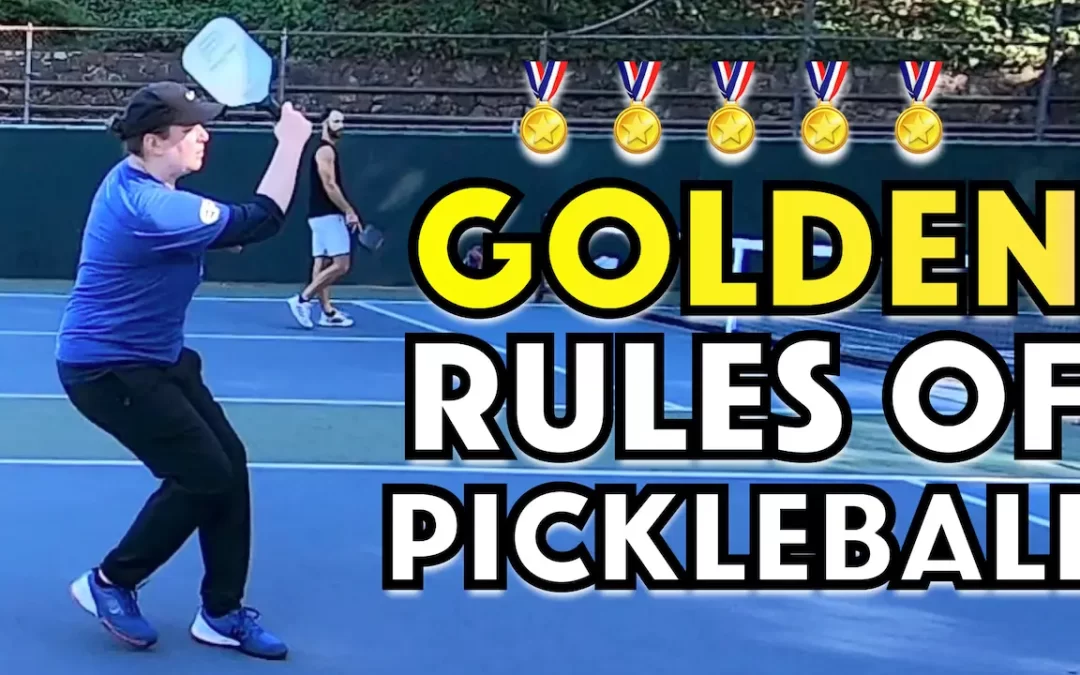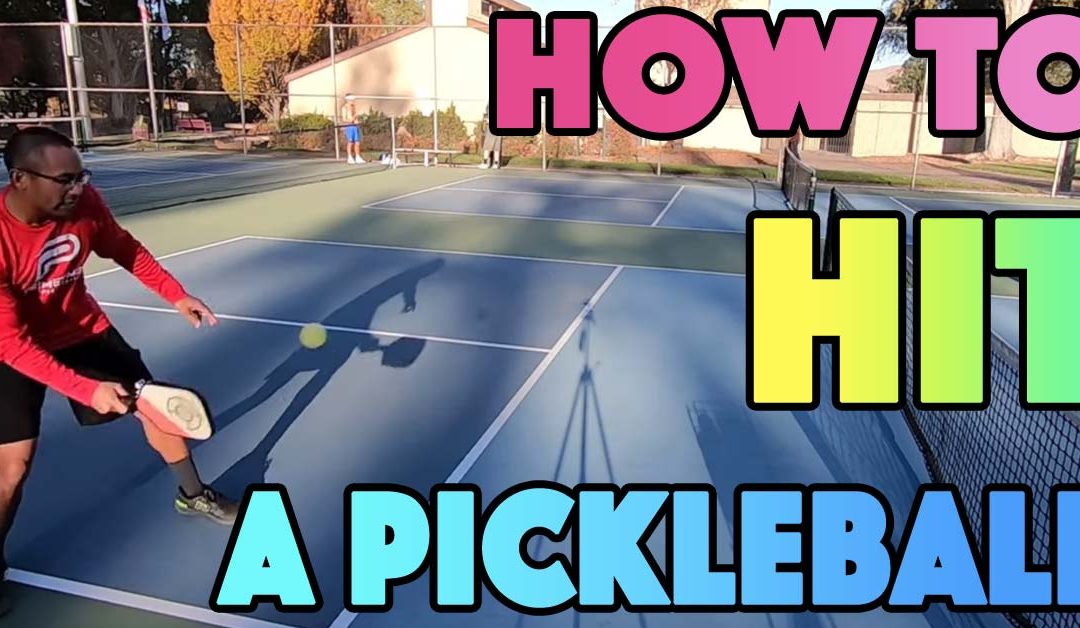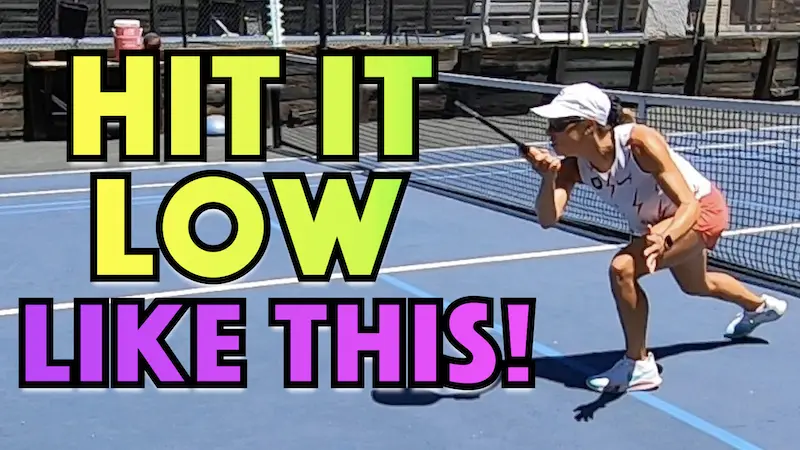Quite possibly the most notorious mistake I see out on the recreational courts, and for those players that just can’t quite seem to get their game to improve, can be summed up in two words… late response.
I see this mistake showing up in three major ways.
I’m going to break down what these are and how to fix them.
When you break past this challenge in your game, it will change your play forever.
You’ll experience a flow and effortlessness as you play that just can’t be achieved without resolving these three major issues.
Refer to time marker 0:53 to see a visual of the scenario described below.
Here we’re going to look at my forehand ground stroke.
I’m making all three of the late response mistakes that I see many players make.
Take a look at a few of these shots.
Can you spot in which three key ways I’m late?
Let’s break them down in sequence.
Late Response #1 – Flat Footed As Opponent Strikes The Ball
My energy is static.
At this point I have no idea where the ball is going to go and yet I’m not ready to move anywhere.
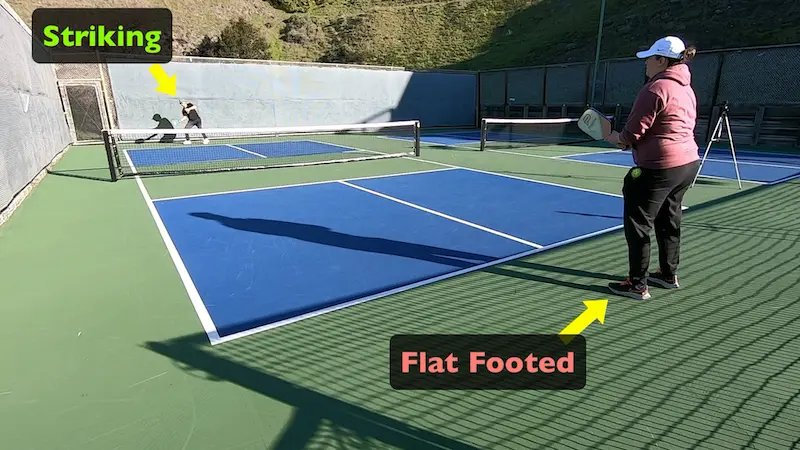
I’ll do okay if it comes right to me and isn’t too fast but if it goes away from me at all and has some speed on it, I’ll be in trouble.
I’ll be pressed when hitting my shot.
Right around the time the ball is being struck by my opponent I need to get some energy going in my legs and get them loaded up so I can use that energy to push off the court and head towards where the ball is going to be.
I want to be clear that this load up is always needed “just in case”.
If the ball happens to come comfortably right to me, then I could have gotten away with not having it built in on that particular shot.
But, the thing is, I’ll never know with any kind of certainty where it’s going as my opponent is striking.
I have to be ready to move just in case.
It’s for this reason I have to do some kind of a load up in my legs every time.
This load I’ve been referring to is also what’s commonly called a split step.
It’s a hop that is timed so that I’m landing on the court at the same time as I will recognize where the ball is going to go so I can move in that direction.
I see many players skipping the split step altogether before every shot and it’s a huge mistake.
You will always be reacting more than you need to be.
Deeper in the court your split step will be a small or a big hop.
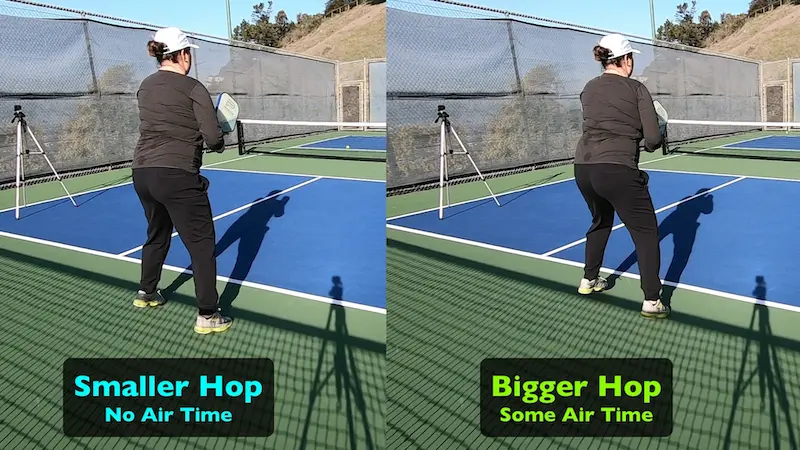
You’ll also have a more pronounced hop anytime you expect to have to defend.
Other times it will make sense to simply have a bounce in your legs where your feet either don’t leave the ground at all or you just raise your heels briefly and kind of bounce on the balls of your feet.
This may be true when you’re in a dink exchange or any time you don’t expect to be very pressed by the next ball that’s coming to you.
It’s a shot-by-shot adjustment.
It’s much more about creating some load in your legs so you can spring off at the right time. That’s the key point here.
Refer to time marker 3:08 for scenario described below.
Here, Taylor and I are dinking. I’m pressing Taylor with my dinks.
They are relatively deep and pushing him to the side and or back.
He must move and stretch to get himself in a good position to get these dinks back.
I don’t expect an attack can reasonably come and if it does it will likely be rather weak simply because he really doesn’t have much of an offensive opportunity as he’s hitting these shots.
As a result, I have a smaller bounce in my legs as I prepare to receive his next shot.
Since he knows he has sent me relatively weak dinks, he knows there’s a much higher chance I could attack him and therefore he has more of a bounce in his preparation knowing he might have to react quickly to my next shot that could come as an attack.
If you find that you’re often late to the ball, then please take a look at your split step and get more of a bounce going in your legs that will help you move out to the shot.
It’s a must in every good player’s game and it’s far too often missing at the recreational and lower levels of play.
What’s another thing that I’m doing causing me to be late and letting the shot play me instead of me playing it?
Late Response #2 – Move Slow To Fast Instead Of Fast To Slow
Refer to time marker 4:31 to see scenario described below.
I see now that the ball is headed away from me but I’m still assessing its speed and depth, so I do head off in that direction but I’m slow about it.
Human nature is taking over and I’m trying to be efficient and not have to move quickly and use up energy unless I absolutely have to.
I see now that the shot is further than I thought and has more pace than I thought so I must pick up my pace if I hope to get to it and get my shot off.
I’m late getting there. I have a later contact than I would like, and my feet are still moving as I’m hitting the shot.
I must overrun it in order to get the shot off in a reasonable way.
All of this will more likely have me hitting a poorer shot than I otherwise could have and I also run further to the side than I needed to leaving me in need of a greater distance to cover in order to recover for the next shot.
Here’s another shot where I start off slow and assess quite late that the ball is deep.
Again, I hit it later than I would like.
I’m still moving and, in this case, falling back as I hit the shot.
Again, I need to be ready just in case.
So instead of moving to the shot slow to fast I should move fast to slow.
That way I’m there early or on time and can calibrate my shot better.
I’ll get a better contact point, I’ll be dynamically balanced as I hit the shot, and I won’t have to take extra steps after I strike so I can recover more efficiently and cover a shorter distance in order to get back.
In order to recover from this late response problem in general you must train yourself out of your natural human instinct to look for efficiencies and simply always be ready to deal with the most difficult shot that could come first and ramp down from there. Not the other way around.
Late Response #3 – Late With Paddle Preparation
This is another reason causing me to be late and letting the shot play me instead of me playing it.
I don’t get my upper body turned as I move to the shot.
I hold my paddle in front of my body and then have a really rushed swing heading into contact.
This will also often contribute to a late contact and generally make it a tougher shot than it needed to be if I had done things differently and earlier.
I can get away with this, just like I can get away with the other three if the ball is coming right to me and is not too fast.
I can wait until the ball bounces or thereabouts and then still time my backswing relatively well to my contact and come out okay.
This breaks down very quickly when the incoming shot has more speed, and I must move quickly to the side or back to deal with it.
I can’t wait for the bounce to start my movement. I must get things going with my upper body and get my turn in place well before the bounce.
Again, I must get ready earlier than might be obvious to be ready just in case for the most difficult shot that could come.
It’s better to have extra time to kill than it is to not have enough time.
You’ll want to get your paddle prepared and your shoulders turned well before the ball bounces.
Notice how it takes a long time for my paddle to go a little way at this part of the motion (see image below) when I have more time. And that’s fine. This is how you’ll kill that extra time.

For the times where I must get through this part a bit faster because the ball is coming faster than I can do that as well.
I’m comfortable either way because I’ve built in that extra time.
You must get comfortable with these two scenarios in your backswing.
You will time your shot with the speed of this section (refer to above image) after the turn but don’t be late getting your turn started and getting to this part of the motion.
Be ready with your turn and paddle preparation just in case.
Notice that the running theme throughout has been to be ready just in case.
Remember be ready to spring to the ball just in case.
Don’t get caught flat-footed, use your split step between every shot, move fast to the ball first and then slow it down when you’re where you need to be.
Same goes for the shoulder turn and paddle preparation. Turn early first and then control the speed of your backswing. Speed up or slow down as needed.
When you’re always ready just in case you can handle the toughest of shots as opposed to going on red alert and then be rushed and jammed leading to a much poorer shot.


